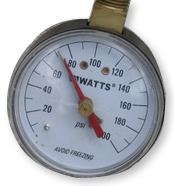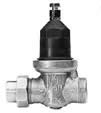Water Pressure 
High water pressure is major cause of leaks, pipe damage, and wasted water. Learn how to detect it, prevent it, and fix it.
While some might consider high water pressure a good thing, water pressure that is too high can cause annoying and expensive damage.
Symptoms of water pressure induced problems include leaks in multiple fixtures in the home, leaks that only appear intermittently - like at night, and toilets running occasionally without being used.
 The most common source of excessive water pressure is the municipal water supplier. The water company sets the pressure to meet their own needs, such as delivering water to fire hydrants, high elevation buildings (or tall ones), and other reasons. This water pressure is often well over 100 psi, and too often over 150 psi. However, the maximum recommended pressure for a residence is 80 psi.
The most common source of excessive water pressure is the municipal water supplier. The water company sets the pressure to meet their own needs, such as delivering water to fire hydrants, high elevation buildings (or tall ones), and other reasons. This water pressure is often well over 100 psi, and too often over 150 psi. However, the maximum recommended pressure for a residence is 80 psi.
You can easily test your water pressure with a gauge, such as the one pictured here, that screws on to a hose bibb. These are usually inexpensive (less than $10) at the home center. A fancier one will have resetable needles that will record the pressure range allowing you to see what happens to the pressure when you aren't watching (such as overnight). They will usually cost around $25.
A pressure regulator for each property ensures that the pressure coming from the municipal supply is reduced to a safe pressure. If the regulator is placed at the meter, instead of just at the entrance to the building, then the regulator will also act to protect the supply line to the house and the many parts of the properties irrigation system. An added benefit of regulating the pressure to the irrigation system is that it will help to reduce misting, thereby increasing the efficiency of the irrigation system - saving water and money. See my video below on how to install one.
Unfortunately, water pressure regulators - like any mechanical device - don't last forever. If you are experiencing the symptoms above and you already have a pressure regulator, it's worth testing your water pressure again, to see if the regulator is operating properly. The video below shows how to do this.
 Excessive water pressure can also be a result of thermal expansion of the water within the home, even when the pressure entering the water supply is within the desired range. You home's plumbing spends most of its time as a closed container. Then, as the water heater heats the water, it expands slightly causing an increase in pressure. A thermal expansion tank within the home's water system absorbs these slight volume changes and prevents pressure fluctuations that can cause system damage.
Excessive water pressure can also be a result of thermal expansion of the water within the home, even when the pressure entering the water supply is within the desired range. You home's plumbing spends most of its time as a closed container. Then, as the water heater heats the water, it expands slightly causing an increase in pressure. A thermal expansion tank within the home's water system absorbs these slight volume changes and prevents pressure fluctuations that can cause system damage.
It's also important to understand that water is a dynamic fluid with mass. When it is stopped suddenly, the mass of the water has a "hammer" effect that greatly increases the force of the water over that of its static pressure. Just like a 1 pound hammer exerts a much greater force when it comes to a sudden stop at the top of a nail; the force of the water hammer effect may cause pipe joints to break, valves to leak, and over time and repeated occurrences, parts to succumb to the force of the water.
How to prevent damage by installing a Pressure Regulator at the meter!
 Protect your plumbing from excessive pressure and improve the efficiency of your irrigation system at the same time! more...
Protect your plumbing from excessive pressure and improve the efficiency of your irrigation system at the same time! more...
Installing a Pressure Regulator with Sharkbite Fittings
 Install a pressure regulator using no-solder Sharkbite™ fittings. Pefect for the DIY plumber.
Install a pressure regulator using no-solder Sharkbite™ fittings. Pefect for the DIY plumber.
more...
How to check your water pressure &
pressure regulator
 Catch dangerous pressure issues before they start to cause leaks and damage!
Catch dangerous pressure issues before they start to cause leaks and damage!
Is your pressure regulator still working properly? Find out!
How to check for hidden leaks
 Easily check for leaks you can't even see by using an inexpensive pressure gauge.
Easily check for leaks you can't even see by using an inexpensive pressure gauge.
How to Adjust Water Pressure
to Save Water
 Adjust your pressure regulator to save water (and money), plus reduce the chances of leaks.
Adjust your pressure regulator to save water (and money), plus reduce the chances of leaks.
It's easy and quick!